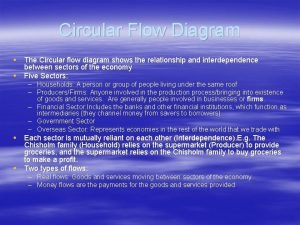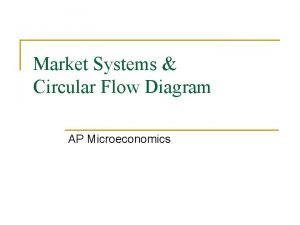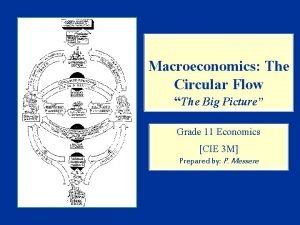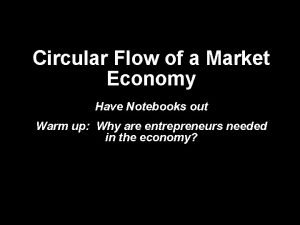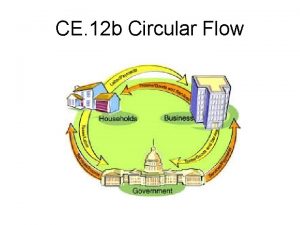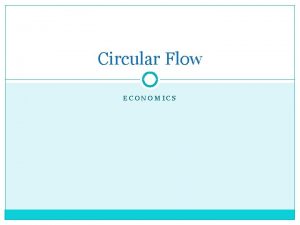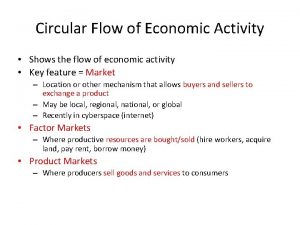Circular Flow Diagram The Circular flow diagram shows






- Slides: 6

Circular Flow Diagram § The Circular flow diagram shows the relationship and interdependence between sectors of the economy § Five Sectors: – Households: A person or group of people living under the same roof – Producers/Firms: Anyone involved in the production process/bringing into existence of goods and services. Are generally people involved in businesses or firms. – Financial Sector: Includes the banks and other financial institutions, which function as intermediaries (they channel money from savers to borrowers) – Government Sector – Overseas Sector: Represents economies in the rest of the world that we trade with § Each sector is mutually reliant on each other (Interdependence). E. g. The Chisholm family (Household) relies on the supermarket (Producer) to provide groceries, and the supermarket relies on the Chisholm family to buy groceries to make a profit. § Two types of flows: – Real flows: Goods and services moving between sectors of the economy – Money flows are the payments for the goods and services provided

Interdependence of Households and Firms (Closed Economy) consumer spending Resources (CELL) Households Firms WRIP (Wages, rent, interest, profit) Finished Goods and services

§ Activities p 121 -122 § Injections and Withdrawals: – When money is taken out from the circular flow we call it a withdrawal (MP, S, T), when money is put into the circular flow, it is termed an injection (XR, G, I). – Injections increase economic activity – Withdrawals decrease economic activity – USE CIRCULAR FLOW LAMINATES AND GO THROUGH EACH SECTOR INDIVIDUALLY. TALK ABOUT DIFFERENT MARKETS.

Markets § Goods and services/Finished goods market: Producers and Households exchange goods and services e. g. sale of a car, online bookstore § Resources market: Households and producers. Demand supply for factors of production e. g. sale of land, advertising job vacancies § Money market: Households, Financial institutions, producers. Flow of consumer savings and producer investment through financial institutions E. g. Bank interest rates for personal savings, interest rates for lending. § Foreign exchange market: Producers and overseas sector. Demand Supply for NZ dollars and overseas currencies due to exports and imports E. g. The NZ Dairy board sells the $US it has received from its US customers in exchange for $NZ. 5

Foreign Exchange Market § Trade with Overseas: § NZ is an open economy and therefore trades with overseas countries. To exchange payments for exports and imports into currencies accepted by the producer, we require a foreign exchange market: § Example: If we buy a car from Japan, we must pay for that car in Yen, not NZ$. Therefore, we need to exchange NZ$ for Yen. Foreign Overseas Market Foreign Exchange Market $NZ Producers/Firms currencies – Balance of Payments: is the value of goods and services exported minus the value of goods and services imported ( XR – MP) – If XR is greater than MP then there is a suplus. If MP is greater than XR then there is a deficit and the country has to borrow, which means our overseas debt increases.

Flow on effects § Must be able to give at least 3 flow on effects of a situation. § For example: “A newspaper article says that economic growth will probably slow and many businesses are likely to close” § Answer: “As economic growth slows producers/firms will produce less goods and services, employment will decrease so household incomes will fall as less overtime etc is available. Because disposable income falls savings will decrease to the financial sector. Banks have less funds so will raise interest on investment to firms, so firms will reduce their investment loans. ” § Example: “NZ Exports are selling well” § Answer: “Export receipts will increase, producers will gain an increase in revenue. Production of goods and services will increase due to higher profits, so employment will rise. Company tax will rise so government revenue from tax will increase. Spending from Govt will increase. ”
